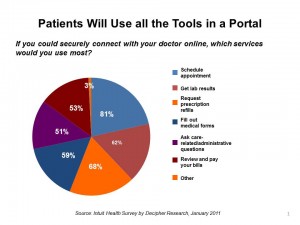 In some surveys, U.S. consumers seem primed for health engagement, liking the ability to schedule appointments with doctors online, emailing providers, and having technology at home that monitors their health status. The chart illustrates some of these stats from a 2011 survey by Intuit.
In some surveys, U.S. consumers seem primed for health engagement, liking the ability to schedule appointments with doctors online, emailing providers, and having technology at home that monitors their health status. The chart illustrates some of these stats from a 2011 survey by Intuit.
However, organizations that develop quality report cards on providers and plans, and developers of mHealth apps, will point out that consumers aren’t rushing to use the quality reports or sustain use of apps: in fact, most downloaded health apps aren’t used after one try, according to PwC’s research.
How do we make sense of these different observations? On my panel at the CONVERGE conference yesterday, Dr. David Delaney of SAP, Dr. Harry Greenspun of Deloitte, and Joel Selzer of Ozmosis and I brainstormed the potential for collaboration among health care stakeholders to bolster patient-centered and value-driven care. We debated what these consumer survey numbers mean, and a twitter stream followed this conversation continuing the dialogue of whether consumers cared about engaging in health.
I asked my team about Castlight Health’s recent influx of $100 mm of funding to build out its consumer-facing tool that provides health care cost and quality information for health citizens shopping, for example, for colonoscopies and knee replacements. While most consumers aren’t rushing to use such tools, Selzer noted that “when” you are newly diagnosed with a condition and are prescribed treatment or therapy, you need access to such information just-in-time.
In 2014 as Health Insurance Exchanges (HIXs) emerge in local markets to channel health plans to people looking to buy into one, Castlight and similar services, such as Change:healthcare, Simplee, HealthcareBlueBook, and ClearCost Health, will be in place to serve that demand. Are we anticipating the Field of Dreams Effect won’t apply this time around — that is, if we build it, people will indeed ‘come’ to take advantage of these oracles of health quality and cost information?
The underlying assumption here is that personal health economics will nudge us to become savvy health care consumers?
But while we like the idea of the health system providing us with Nordstrom-style service levels — which is how people tend to judge quality, and not always by clinical outcomes, as Dr. Greenspun noted on the panel —
The “skin-in-the-game” hypothesis is what we’re testing with respect to the growth of consumer-driven health plans in the context of value-based financing. We know that this is where the puck is going. What we don’t know yet is how quickly we’re getting ‘there.’
Health Populi’s Hot Points: The first iteration of consumer-driven health care hasn’t yielded a health citizenry of savvy shoppers. Instead, too many consumers delay necessary health care, split prescribed pills, and forgo recommended clinical tests to save “their” money. With high-deductible health plans reaching $2,000 in 2012, consumers lack health plan literacy: the toolkit of just how to smartly use their new health plan design.
A growing number of well-designed and venture capital-backed tools are emerging to help that consumer make sense out of the self-health managing labyrinth, Castlight Health and Consumer Reports report cards among them. The question remains how quickly consumers will adopt these tools in their journey toward savvy health shopping. As with all health adoption, a cadre of pioneering consumers will be early adopters, and a cohort will never cotton on to health engagement. For the mass middle, it will take more than an out-of-pocket cost ‘nudge’ to get them engaged. This is a huge area of opportunity for entrepreneurs to fill.




 Thank you FeedSpot for
Thank you FeedSpot for